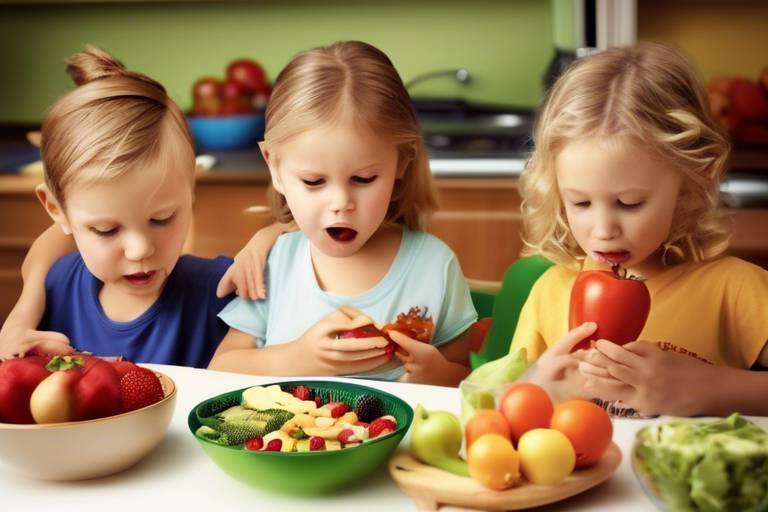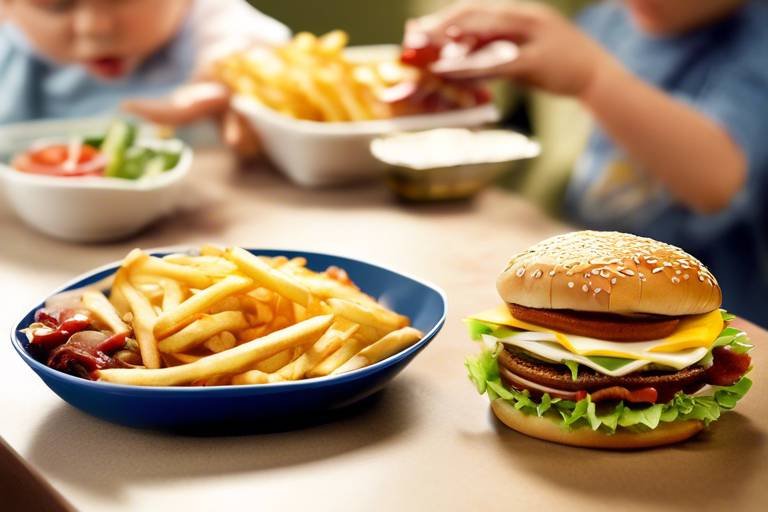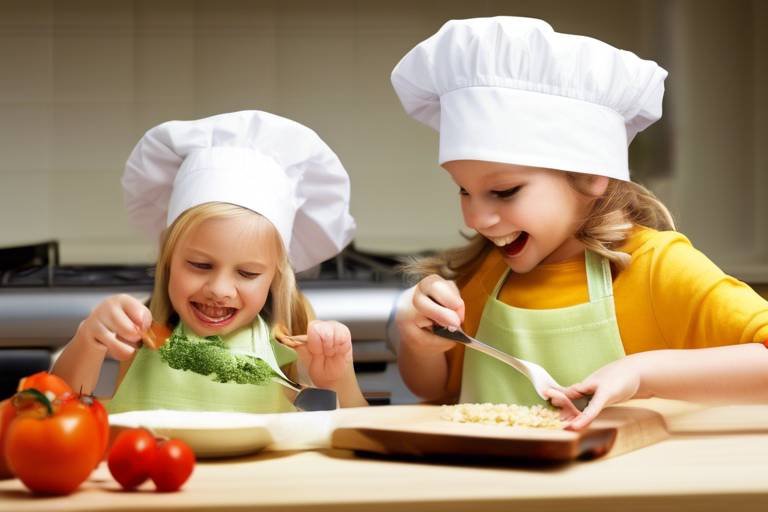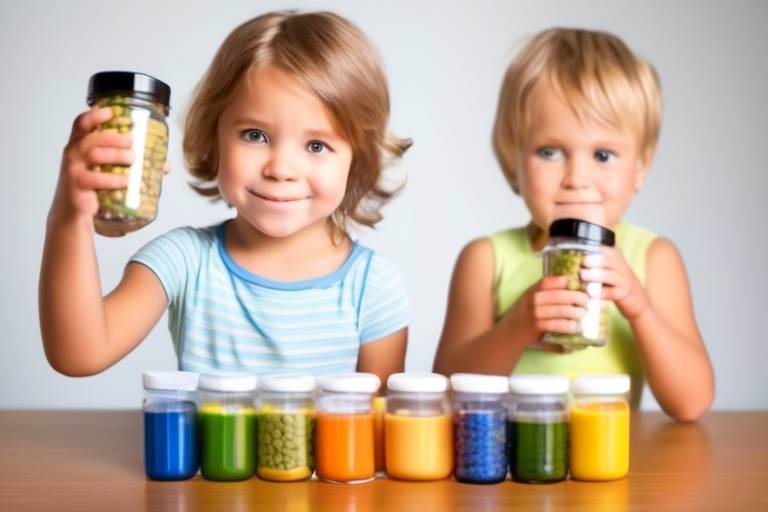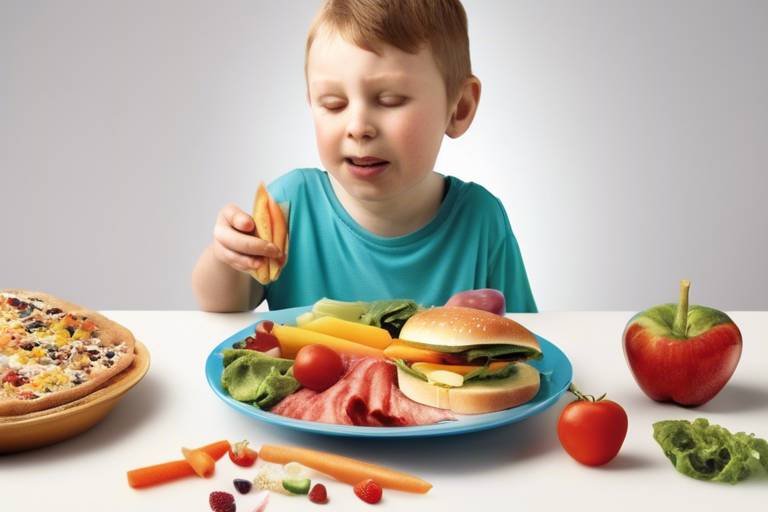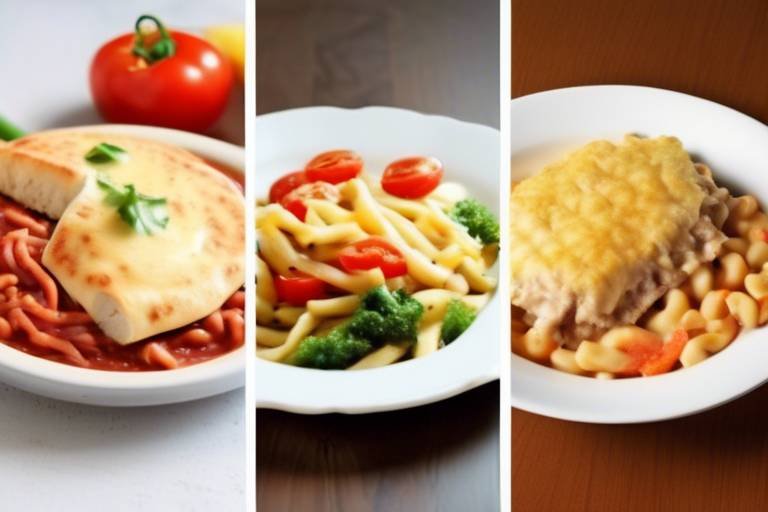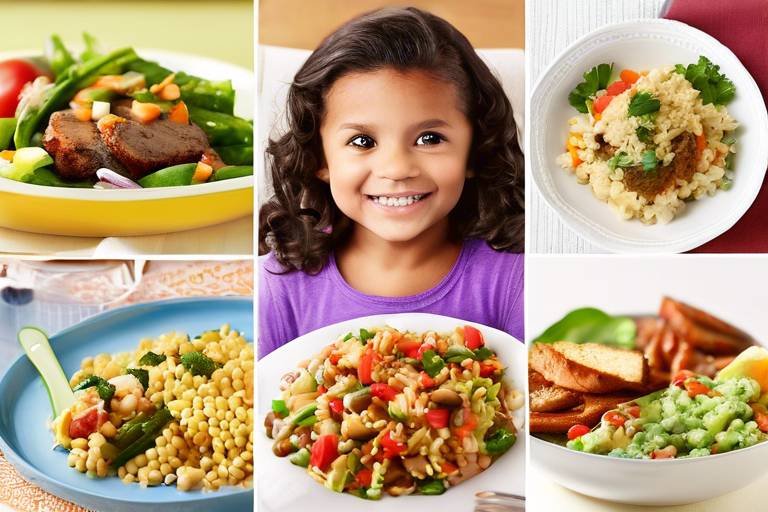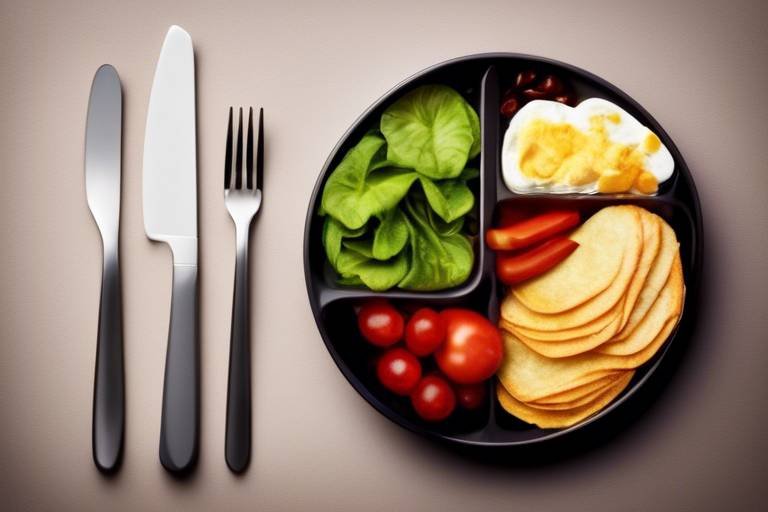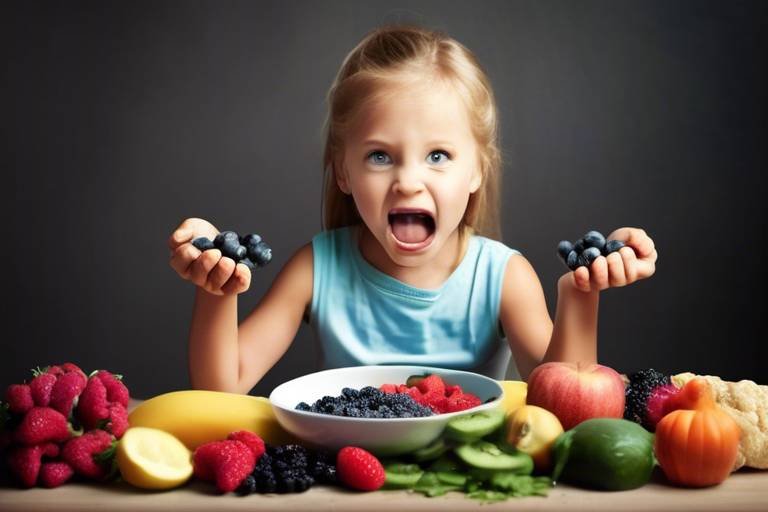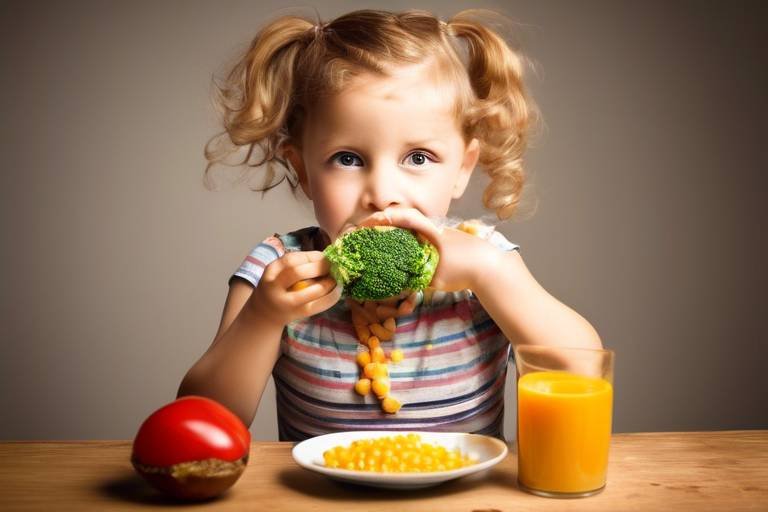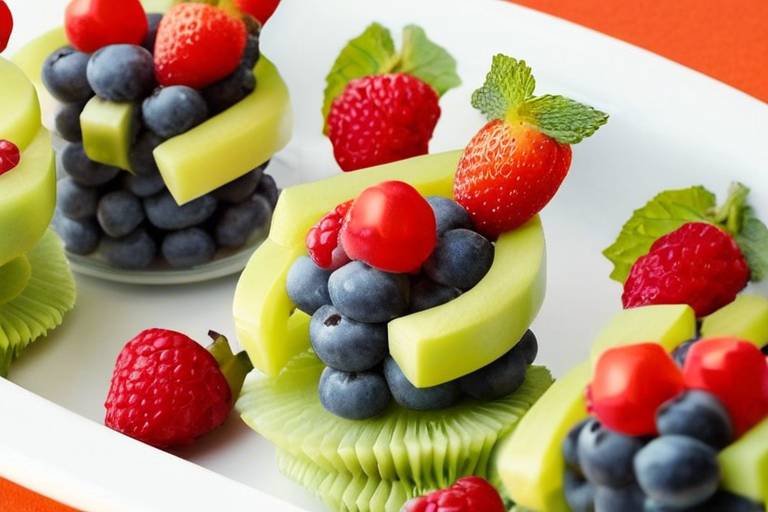Teaching Your Kids to Make Healthy Food Choices
In a world filled with fast food options and sugary snacks, teaching your kids to make healthy food choices can feel like an uphill battle. But fear not! With the right strategies and a sprinkle of creativity, you can guide your little ones towards a lifelong appreciation for nutritious foods. This article explores effective methods to instill healthy eating habits in children, emphasizing the importance of nutrition education, practical tips, and engaging activities that make healthy eating not just a necessity but a fun adventure!
Understanding nutrition is crucial for children's development. Think about it: just like a car needs the right fuel to run smoothly, our bodies need proper nutrients to grow strong and healthy. Teaching kids about healthy eating is essential for their physical and mental well-being. When children learn about the benefits of fruits, vegetables, whole grains, and proteins, they’re more likely to make informed choices. This knowledge sets the foundation for lifelong healthy habits, reducing the risk of obesity, diabetes, and other health issues in the future. It’s not just about what they eat today; it’s about building a healthier tomorrow!
A supportive food environment is like having a garden where healthy choices can flourish. By creating a kitchen and dining space that promotes nutritious options, you make it easier for kids to choose healthy foods. Stock your pantry with colorful fruits, crunchy vegetables, and whole grain snacks. Instead of hiding away the cookies, display a bowl of fresh apples on the counter. When kids see healthy foods readily available, they’re more likely to reach for them.
Engaging children in meal planning is a fantastic way to spark their interest in food. It’s like giving them the keys to their own culinary adventure! Involve them in selecting recipes, making grocery lists, and even prepping the meals. When kids have a hand in creating their meals, they’re more likely to enjoy what they eat. Try asking questions like, “What do you want to try this week?” or “Which vegetables do you think would taste great in our stir-fry?” This not only empowers them but also helps develop their decision-making skills.
Grocery shopping can be transformed into an educational adventure. Instead of viewing it as a chore, turn it into a fun family outing! As you stroll through the aisles, teach your kids about nutrition labels, food groups, and how to make healthy selections. For example, you can create a game where they have to find the healthiest snack option or identify fruits and vegetables of different colors. This not only makes shopping enjoyable but also reinforces what they’ve learned about healthy eating.
Cooking is a valuable skill that can foster a love for healthy foods. When families cook together, it becomes a bonding experience filled with laughter and creativity. Encourage your kids to explore healthy recipes and experiment with different ingredients. You can even have a themed dinner night, where each family member chooses a healthy dish from a different culture. This not only introduces them to diverse foods but also helps them appreciate the effort that goes into preparing meals.
Understanding portion sizes is vital for balanced eating. Kids often struggle with knowing how much food is enough, leading to overeating or wasting food. Teach them about appropriate serving sizes by using visual aids, like comparing a serving of pasta to the size of their fist. Encourage them to listen to their hunger cues by asking questions like, “Are you still hungry, or are you full?” This practice not only helps them make better choices but also fosters a healthy relationship with food.
Let’s face it: kids are more likely to eat healthy foods if they’re presented in a fun and exciting way. Creativity can be your best friend in the kitchen! Try arranging fruits and vegetables into fun shapes or creating colorful smoothies that look like works of art. You can even have themed meals based on their favorite movies or characters. For instance, make “Hulk” green smoothies or “Frozen” fruit pops. When healthy eating feels like an adventure, kids will be more inclined to dig in!
Finding healthy snacks can be challenging, especially when kids are bombarded with advertisements for sugary treats. However, there are plenty of nutritious snack options that are easy to prepare and appealing to children. Consider offering alternatives such as:
- Yogurt with fresh fruits
- Carrot sticks with hummus
- Whole grain crackers with cheese
- Popcorn seasoned with herbs
These snacks not only satisfy hunger but also provide essential nutrients, promoting better snacking habits.
Mindful eating is all about being present during meals and appreciating the food on your plate. Teach kids to eat slowly, savor each bite, and recognize when they’re full. You can create a fun ritual before meals, like sharing one thing they’re grateful for about their food. This practice fosters a deeper connection with what they consume and encourages them to make thoughtful choices.
Q: How can I get my picky eater to try new foods?
A: Start by introducing new foods alongside their favorites. Make it fun by creating a taste-testing game where they can rate each food item. Patience is key!
Q: What are some easy ways to incorporate more fruits and vegetables into meals?
A: Add fruits to breakfast cereals, blend veggies into smoothies, or sneak them into sauces. Get creative!
Q: How do I teach my child about nutrition without overwhelming them?
A: Use simple language and relatable analogies. Turn lessons into games or activities to keep it engaging.

The Importance of Nutrition Education
This article explores effective strategies for guiding children towards healthier eating habits, emphasizing the importance of nutrition education, practical tips, and engaging activities to foster a lifelong appreciation for nutritious foods.
Understanding nutrition is crucial for children's development. It’s not just about what’s on their plate; it’s about building a foundation for their physical and mental well-being. When kids grasp the significance of healthy eating, they’re more likely to make better choices as they grow. Think of nutrition education as planting seeds in a garden. If you nurture those seeds, they’ll blossom into lifelong habits. Imagine a world where your children not only enjoy fruits and vegetables but also understand why they’re so vital for their health!
Nutrition education should start early. Kids are naturally curious, and teaching them about food can be an exciting adventure. By explaining the benefits of different food groups, such as fruits, vegetables, grains, proteins, and dairy, you’re equipping them with the knowledge to make informed choices. For example, you might say, “Did you know that carrots can help you see better in the dark?” This kind of engaging information can spark their interest and encourage them to try new foods.
Moreover, nutrition education isn’t just about eating healthy; it’s also about understanding moderation and balance. Teaching kids about portion sizes and the importance of not overindulging can help them develop a healthy relationship with food. For instance, you might introduce the concept of a balanced plate, where half is filled with fruits and vegetables, a quarter with grains, and the last quarter with protein. This way, they can visually grasp how to build a nutritious meal.
Incorporating fun activities can also enhance nutrition education. Here are a few ideas to get you started:
- Food Art: Create fun shapes and designs with fruits and vegetables to make a colorful plate.
- Cooking Demos: Hold mini cooking classes at home where kids can help prepare healthy meals.
- Gardening: If possible, start a small garden where kids can grow their own fruits and vegetables.
By making nutrition education interactive and enjoyable, you’re more likely to instill lasting habits in your children. They’ll not only learn about healthy foods but also develop a sense of empowerment and responsibility regarding their eating choices. So, the next time you sit down for a meal, remember that every bite is a chance to teach and inspire!
A supportive food environment encourages healthy choices. This section covers how to create a kitchen and dining space that promotes nutritious options, making it easier for kids to choose healthy foods.
Engaging children in meal planning fosters interest in food. This subheading highlights activities that allow kids to participate in selecting and preparing meals, making them more likely to enjoy healthy foods.
Grocery shopping can be an educational adventure. This part discusses how to turn grocery trips into fun learning experiences, teaching kids about nutrition labels, food groups, and making healthy selections.
Cooking is a valuable skill. This section emphasizes the benefits of cooking together, encouraging kids to explore healthy recipes and develop an appreciation for nutritious ingredients.
Understanding portion sizes is vital for balanced eating. This subheading explains techniques for teaching kids about appropriate serving sizes and how to listen to their hunger cues.
Fun and creativity can make healthy eating appealing. This section provides ideas for making nutritious foods enjoyable, including fun presentations and themed meals that excite children's taste buds.
Finding healthy snacks can be challenging. This subheading offers suggestions for nutritious snack options that are easy to prepare and appealing to children, promoting better snacking habits.
Mindful eating promotes awareness of food choices. This section discusses techniques for teaching kids to eat slowly and savor their meals, fostering a deeper connection with the food they consume.
Q: How can I get my kids interested in healthy eating?
A: Involve them in meal planning and preparation. Make it fun by creating colorful plates or trying new recipes together!
Q: What are some good resources for teaching kids about nutrition?
A: Look for children's cookbooks, educational websites, and apps that focus on nutrition and healthy eating.
Q: How can I encourage my kids to try new foods?
A: Offer a variety of foods and involve them in cooking. Sometimes, kids are more willing to try something they helped make!

Creating a Positive Food Environment
Creating a positive food environment is a game-changer when it comes to encouraging our kids to make healthier food choices. Imagine walking into a kitchen that feels like a vibrant garden of colors, scents, and flavors! It’s not just about having fresh fruits and vegetables on hand; it’s about crafting an atmosphere that celebrates nutritious eating and makes it a fun and engaging experience for children. A positive food environment can significantly influence how kids perceive food, turning healthy eating from a chore into an adventure.
First and foremost, let’s talk about the importance of visibility. When healthy foods are easily accessible and prominently displayed, children are more likely to reach for them. Think of your kitchen as a showcase for nutritious foods. Keep a bowl of fresh fruits like apples, bananas, and oranges on the counter, and store veggies at eye level in the fridge. This simple act not only makes healthy options more visible but also encourages kids to grab them as snacks instead of reaching for less nutritious options.
Next, consider the atmosphere of your dining space. A positive food environment is not just about the food itself; it’s also about how we present it. Set the table with colorful plates and utensils, and create a warm, inviting space for family meals. When kids feel excited about the presentation, they’re more inclined to try new foods. You might even want to involve them in decorating the table or choosing the meal theme for the week, making them feel like they have a stake in the process.
In addition, involving kids in the grocery shopping process can transform their relationship with food. When children help select the foods they want to eat, they’re more likely to try those foods when they come home. This can be a fun adventure! Turn grocery shopping into a treasure hunt where they look for colorful fruits and veggies, or challenge them to find a new healthy snack to try. You could even create a simple chart to track their favorite healthy foods, making it a fun game:
| Favorite Healthy Food | Why They Like It |
|---|---|
| Carrot Sticks | Crunchy and sweet! |
| Apple Slices | They're juicy and easy to dip! |
| Yogurt | It's creamy and comes in fun flavors! |
Finally, let’s not forget about the power of routine. Kids thrive on consistency, so establishing regular meal and snack times can help them develop a healthy relationship with food. Make it a family tradition to have dinner together whenever possible. This not only allows for quality time but also gives kids the opportunity to see adults modeling healthy eating behaviors. They’re more likely to try new foods when they see you enjoying them, too!
In summary, creating a positive food environment is about more than just the food itself; it’s about fostering a space that encourages exploration, creativity, and connection with what we eat. By making healthy foods visible, involving kids in the shopping and cooking process, and establishing routines, we can help them develop a lifelong appreciation for nutritious foods. So, let’s transform our kitchens into culinary playgrounds that inspire healthy choices!
Q: How can I encourage my child to try new foods?
A: Involve them in the cooking process, offer a variety of colorful foods, and make it a fun adventure! You can also try presenting the food in creative ways or pairing it with their favorite dips.
Q: What are some good snacks for kids?
A: Healthy snacks can include fruit slices, yogurt, nut butter with whole-grain crackers, or veggie sticks with hummus. The key is to keep it simple and appealing!
Q: How do I handle picky eaters?
A: Be patient and persistent. Offer new foods alongside their favorites, and try not to pressure them. Sometimes it takes several exposures to a new food before they’ll try it!

Involving Kids in Meal Planning
Getting your kids involved in meal planning is like giving them the keys to a treasure chest of healthy eating! When children take part in deciding what goes on their plates, they feel a sense of ownership and excitement about the food they eat. Think about it: when was the last time you were genuinely excited about a meal that someone else planned for you? Exactly! By letting kids have a say, you’re not just filling their bellies; you’re filling their minds with knowledge about nutrition and healthy choices.
One way to kick off this culinary adventure is by setting aside some time each week for a family meal planning session. Gather around the kitchen table, armed with colorful cookbooks, magazines, or even a tablet with your favorite recipe websites. Encourage your kids to flip through the pages and pick out dishes that catch their eye. This not only makes them feel involved but also sparks their creativity. Who knows? They might come up with a wild combination of ingredients that surprises you!
Incorporating a variety of food groups is essential. As you plan meals together, discuss the different food groups—fruits, vegetables, grains, proteins, and dairy. You can create a fun little chart to help them visualize what a balanced plate looks like. Here’s a simple example:
| Food Group | Examples |
|---|---|
| Fruits | Apples, Bananas, Berries |
| Vegetables | Carrots, Spinach, Broccoli |
| Grains | Brown Rice, Quinoa, Whole Wheat Bread |
| Proteins | Chicken, Tofu, Beans |
| Dairy | Yogurt, Cheese, Milk |
Once you've chosen the meals, it's time to hit the grocery store! But remember, this isn’t just a chore; it’s an adventure! Turn your shopping trips into scavenger hunts where your kids can check off items from their meal plan. Ask them to find a new fruit or vegetable to try, which can lead to exciting discoveries. Who knows? Your child might just fall in love with kale or discover that they enjoy the crunch of snap peas!
Additionally, cooking together as a family can be a delightful bonding experience. Assign age-appropriate tasks to your kids, whether it’s washing veggies, stirring sauces, or even measuring out ingredients. This hands-on involvement not only teaches them valuable cooking skills but also instills a sense of pride in their culinary creations. Imagine the joy on their faces when they serve a meal they helped prepare!
Lastly, don’t forget to celebrate your meal planning victories. After enjoying a meal together, take a moment to discuss what everyone liked about it. This positive reinforcement encourages them to keep participating in future planning sessions. By making meal planning a fun and engaging process, you're not just teaching them about food; you're fostering a lifelong love for healthy eating!
Q: How can I get my picky eater involved in meal planning?
A: Start by introducing them to a variety of foods in a fun way. Use their favorite characters or themes to make the process exciting. Encourage them to choose one new food each week to try!
Q: What if my kids choose unhealthy options?
A: Use this as a teaching moment! Discuss why certain foods are healthier than others and guide them towards making better choices without taking away their autonomy.
Q: How often should we plan meals as a family?
A: Aim for once a week! This gives everyone something to look forward to and allows kids to get involved in the process without feeling overwhelmed.

Fun Grocery Store Trips
Grocery shopping doesn’t have to be a mundane chore; in fact, it can be an exhilarating adventure for you and your kids! Imagine transforming a simple trip to the grocery store into a thrilling scavenger hunt, where your little ones are not just passive observers but active participants in the quest for healthy foods. By turning grocery shopping into a game, you can instill a sense of excitement and curiosity about nutrition that will last a lifetime.
Start by creating a shopping list together. Instead of just handing them a list, involve your kids in the process by asking them what healthy foods they enjoy or would like to try. This not only gives them a sense of ownership but also encourages them to think critically about their food choices. You can even categorize the list by food groups, which can be a fun way to teach them about different types of nutrition. For example, you might have sections for fruits, vegetables, grains, and proteins. This way, they learn to recognize and appreciate the variety of foods available.
As you navigate the aisles, make it a point to discuss nutrition labels. This is a fantastic opportunity to teach your kids how to read labels and understand what they mean. You might say, “Look at this cereal! Can you find the one with the most fiber?” This not only makes them engaged but also empowers them to make informed choices. You could also create a mini-competition: “Let’s see who can find the healthiest snack!” This friendly competition can spark their interest in healthier options.
Don’t forget to explore the produce section! Encourage your kids to pick out a new fruit or vegetable they’ve never tried before. You can ask questions like, “What color is this? How do you think it tastes?” This kind of interaction not only makes them more adventurous eaters but also helps them learn about the importance of incorporating a rainbow of colors into their diets. You can even create a taste test challenge at home with the new items they select, making it a fun family activity!
Finally, as you head to the checkout, take a moment to talk about budgeting and making choices. Explain why you are choosing certain items over others and how to stick to a budget. This can be an excellent life lesson that goes beyond just food. By the end of the trip, your kids won’t just have a bag full of groceries; they’ll have a newfound appreciation for healthy eating and an understanding of how to make smart food choices.
In conclusion, grocery store trips can be transformed from a mundane task into a fun and educational experience. By involving your kids in the process, you not only teach them about healthy eating but also create lasting memories that will encourage them to make better food choices in the future. So, next time you head to the store, remember: it’s not just about what you buy; it’s about the adventure you create along the way!
- How can I make grocery shopping more fun for my kids? Try turning it into a game or a scavenger hunt, involve them in making the shopping list, and encourage them to pick out new foods to try.
- What should I teach my kids about nutrition while shopping? Focus on reading nutrition labels, understanding food groups, and encouraging them to try a variety of fruits and vegetables.
- How can I encourage my kids to make healthier choices? Engage them in discussions about food choices, create challenges, and model healthy eating habits yourself.

Cooking Together as a Family
Cooking together as a family is not just about preparing meals; it's about creating lasting memories and building strong relationships. When you invite your kids into the kitchen, you're opening the door to a world of fun, creativity, and learning. Imagine the laughter as flour flies and the excitement of tasting a new dish that everyone contributed to! It's an opportunity to bond, share stories, and cultivate an appreciation for healthy eating that can last a lifetime.
Moreover, cooking together can be a fantastic way to teach children essential life skills. From measuring ingredients to following a recipe, kids learn valuable lessons in math and science without even realizing it. For instance, measuring cups can turn into a fun way to explore fractions, while mixing ingredients can spark discussions about chemical reactions. The kitchen becomes a classroom where the curriculum is delicious!
To make cooking together even more engaging, consider choosing recipes that allow for creativity. Let your kids pick a dish they want to try, or challenge them to create their own version of a family favorite. This not only empowers them but also ignites their culinary curiosity. You might be surprised by their innovative ideas—who knows, you might end up with a new family recipe!
It's also essential to embrace the mess that comes with cooking. Children learn best through hands-on experiences, and while the kitchen may get a bit chaotic, those moments of laughter and spontaneity are what make family cooking truly special. Encourage your kids to experiment with flavors and ingredients, and don't forget to celebrate their successes, no matter how small. A simple "Wow, you chopped those veggies like a pro!" can boost their confidence and encourage them to keep exploring.
As you cook together, take the time to discuss the nutritional value of the ingredients you're using. Explain why certain foods are good for them and how they contribute to their health and well-being. This conversation can help them make better food choices in the future. You could even create a fun chart to track their favorite healthy ingredients, turning the learning experience into a game.
Incorporating themed cooking nights can also add an exciting twist to your family cooking sessions. For example, you could have "Taco Tuesdays" where everyone assembles their own tacos or "Pasta Fridays" where you make fresh pasta together. Not only does this make meals more enjoyable, but it also gives everyone something to look forward to each week. Plus, it’s a great way to introduce kids to different cuisines and cultures, broadening their palates and culinary experiences.
Ultimately, cooking together as a family is about more than just food; it’s about connection, creativity, and communication. So the next time you're in the kitchen, invite your kids to join you. You might just find that the time spent together is the most delicious ingredient of all!
- What age should I start involving my kids in cooking? It's great to start as early as possible! Even toddlers can help with washing vegetables or stirring ingredients. As they grow, you can introduce more complex tasks.
- How can I make cooking less stressful? Plan ahead! Choose recipes that are simple and fun, and prepare ingredients in advance. Remember, it's about enjoying the time together, not just the end result.
- What if my kids are picky eaters? Involve them in the process! Let them choose ingredients or help prepare their meals. This can often make them more willing to try new foods.

Teaching Portion Control
Understanding portion sizes is vital for balanced eating, especially for children who are still developing their relationship with food. Kids often have a natural tendency to overeat or underestimate the amount of food they need. This can lead to unhealthy habits that may persist into adulthood. To combat this, it's essential to teach children about portion control in a way that feels engaging and relatable.
One effective method is to use visual aids. For instance, you can show your kids what an appropriate portion looks like by comparing it to familiar objects. For example, a serving of pasta can be likened to the size of a baseball, while a piece of meat should be about the size of a deck of cards. Using these comparisons helps children grasp the concept of portion sizes without feeling overwhelmed by numbers. You can even create a fun chart together that illustrates these comparisons, which can be displayed in the kitchen as a constant reminder.
Another practical approach is to involve your kids in the process of serving their own meals. Allowing them to scoop their own portions can encourage them to listen to their hunger cues. You might say, “Why don’t you take what you think you’ll eat, and if you’re still hungry, you can always come back for more?” This empowers them to make choices based on their own needs rather than simply finishing what’s on their plate. It also helps them develop a sense of responsibility regarding their food intake.
To further enhance their understanding of portion control, consider implementing a family "portion control night." This can be a fun and educational experience where everyone prepares a meal together, focusing on serving sizes. You can create a game out of it by challenging each family member to guess the correct portion size for different foods. Not only does this make learning about portion sizes enjoyable, but it also fosters family bonding over healthy eating practices.
Additionally, teaching kids to listen to their bodies is crucial. Encourage them to recognize their hunger and fullness signals. You can ask questions like, “Are you still hungry, or are you feeling full?” This dialogue reinforces the importance of tuning into their bodies rather than eating out of habit or boredom. Over time, they will develop a more intuitive understanding of their own needs, leading to healthier eating habits.
Incorporating these strategies can make a significant difference in your child's eating habits. By making portion control a fun and interactive learning experience, you’re not just teaching them about food; you’re helping them build a foundation for a healthy lifestyle that will last a lifetime.
- Why is portion control important for kids? Portion control helps prevent overeating and teaches children to listen to their hunger cues, promoting a healthier relationship with food.
- How can I teach my child about portion sizes? Use visual comparisons, involve them in meal preparation, and create engaging activities that focus on serving sizes.
- What are some fun ways to make portion control exciting? Organize family games around portion sizes, create charts, or have themed nights where everyone prepares their meals with a focus on portion control.

Making Healthy Foods Fun
When it comes to getting kids excited about healthy eating, the key is to make it fun and engaging. Think of healthy foods as a canvas, and your kids as little artists ready to create their masterpieces! By incorporating elements of play and creativity into meals, you can transform nutritious foods into delightful experiences that not only satisfy hunger but also spark joy. One way to do this is by creating visually appealing plates. For example, you can arrange fruits and vegetables into fun shapes or use colorful ingredients to make a rainbow salad. This not only makes the food more attractive but also encourages kids to try a variety of items.
Another fantastic idea is to introduce themed meals. Imagine a “Taco Tuesday” where kids can build their own tacos with healthy fillings like grilled chicken, beans, and a rainbow of veggies. Or how about a “Pizza Night” where they can top whole grain pita bread with tomato sauce, cheese, and an array of colorful vegetables? This interactive approach allows children to take charge of their meals, making them more likely to enjoy and appreciate what they’re eating. Plus, it’s a great opportunity for family bonding!
Incorporating games into mealtime can also be a hit. You might create a “food scavenger hunt” where kids have to find different healthy ingredients in the kitchen or garden. This not only teaches them about various foods but also gets them moving and excited about what they’ll be eating. You can even reward them with a fun sticker or a small prize for their efforts!
Don't forget about the power of presentation. Kids are naturally drawn to colors and shapes. Try using cookie cutters to create fun shapes out of fruits and veggies, or serve smoothies in fun glasses with silly straws. You could even have a “build your own smoothie” bar where kids can mix and match their favorite fruits and toppings. The more involved they are in the process, the more they will love the outcome!
Finally, consider hosting a “Healthy Food Challenge” where kids can experiment with new recipes or ingredients each week. This not only encourages creativity but also helps them develop a sense of ownership over their food choices. By celebrating their culinary creations, you reinforce the idea that healthy eating can be both enjoyable and rewarding.
In summary, making healthy foods fun is all about creativity, involvement, and a little bit of playfulness. By transforming meals into exciting adventures, you can cultivate a positive relationship with food that lasts a lifetime. So, roll up your sleeves, unleash your inner chef, and let the healthy eating fun begin!
- How can I encourage my child to try new healthy foods?
Start by introducing new foods alongside their favorites, and make it a fun experience. Use creative presentations and involve them in the preparation process to pique their interest.
- What are some easy healthy snacks for kids?
Some great options include yogurt with fruit, whole grain crackers with cheese, or sliced veggies with hummus. These snacks are not only nutritious but also easy to prepare!
- How can I teach my kids about portion control?
Use visual aids, like comparing portions to everyday objects (e.g., a serving of pasta is about the size of a tennis ball). Encourage them to listen to their hunger cues and serve smaller amounts to start with.

Healthy Snack Alternatives
Finding healthy snacks that kids actually want to eat can sometimes feel like searching for a needle in a haystack. But fear not! There are plenty of nutritious options that are not only good for them but also taste amazing. The key is to make these snacks appealing and fun. Think of healthy snacks as a treasure hunt where each discovery is a delicious and nutritious gem waiting to be uncovered!
First off, let’s talk about fruits and vegetables. While it might sound cliché, they truly are nature's candy! You can transform a simple apple into a fun snack by slicing it up and pairing it with a little peanut butter or yogurt dip. Kids love to dip! Similarly, carrots and celery sticks can be served with hummus or guacamole. This not only adds flavor but also introduces them to a variety of textures and tastes. The vibrant colors of fruits and veggies can also make a plate look like a rainbow, which is visually appealing to children.
Another fantastic option is to create homemade trail mix. You can involve your kids in the process by letting them pick their favorite nuts, seeds, and dried fruits. This not only gives them a sense of ownership over their snacks but also teaches them about different food groups. You can even sneak in some dark chocolate chips for a touch of sweetness! Just be sure to keep the portions reasonable, as nuts can be calorie-dense.
For those moments when you want something crunchy, whole-grain popcorn is a fantastic alternative to chips. It’s low in calories and can be flavored in numerous ways. You can sprinkle it with a bit of cheese powder, cinnamon, or even a touch of olive oil and herbs for a savory treat. The best part? Making popcorn can be a fun activity in itself, with the popping sound and the delightful aroma filling the kitchen.
If you’re looking for something more substantial, consider making energy bites. These little power-packed balls can be made with oats, nut butter, and a variety of mix-ins like flaxseed, chia seeds, or mini chocolate chips. They are incredibly easy to make and can be stored in the fridge for a quick grab-and-go snack. Plus, they provide a great source of energy for those busy afternoons!
To wrap it all up, the journey to healthy snacking doesn’t have to be boring or bland. With a little creativity and involvement from your kids, you can turn snack time into an exciting and educational experience. Remember, the goal is to create a positive relationship with food that encourages them to make better choices in the long run.
- What are some easy healthy snacks for kids?
Some easy healthy snacks include sliced fruits with yogurt dip, veggie sticks with hummus, homemade trail mix, and whole-grain popcorn. The key is to keep it simple and fun!
- How can I make healthy snacks more appealing to my kids?
Try to involve your kids in the snack-making process, use vibrant colors, and present the food in fun shapes or designs. Making it interactive can also help!
- Are store-bought healthy snacks a good option?
Store-bought healthy snacks can be convenient, but it’s essential to read the labels. Look for options with minimal added sugars and whole ingredients. Homemade snacks are often a healthier choice.

Encouraging Mindful Eating
In our fast-paced world, it's easy for kids to rush through meals without truly experiencing the joy of eating. Mindful eating is all about being present during mealtimes, savoring each bite, and understanding the food they consume. But how do we instill this practice in our children? It starts with creating a calm, distraction-free environment where they can focus on their food. Imagine sitting down together at the dinner table, free from screens and noise, allowing everyone to engage fully with their meal. This simple act can transform mealtime into a cherished family ritual.
One effective technique to promote mindful eating is to encourage slow eating. Kids can be taught to take smaller bites and chew their food thoroughly. This not only aids digestion but also helps them recognize their body's hunger and fullness cues. You might say, "Let's try to count how many times we can chew each bite before swallowing!" This playful approach can make the process fun and engaging.
Another strategy is to involve children in the sensory experience of eating. Encourage them to observe the colors, textures, and aromas of their food. Ask questions like, "What do you smell in this dish?" or "How does this feel in your mouth?" Such questions can stimulate their curiosity and enhance their appreciation for different foods. You could even create a sensory chart together, where they can rate their meals based on taste, smell, and texture.
To further reinforce mindful eating, consider implementing a “no distractions” rule during meals. This means no phones, tablets, or television. Instead, focus on conversation and connection. You might share stories from your day or discuss the origins of the food on your plate. This not only makes meals more enjoyable but also strengthens family bonds. You can even turn it into a game where each family member shares something interesting about their food or a fun fact related to nutrition.
It’s also essential to teach kids the importance of listening to their bodies. Encourage them to pause during meals and ask themselves, “Am I still hungry?” or “Am I starting to feel full?” This practice can help develop a healthier relationship with food and prevent overeating. You might create a simple chart to help them track their hunger levels before and after meals, making them more aware of their eating habits.
Incorporating these mindful eating practices can be a game changer for your family. Not only does it promote healthier eating habits, but it also cultivates a deeper appreciation for food. So, why not turn mealtime into a delightful experience that your kids will look forward to? By making it fun, engaging, and educational, you’re setting them up for a lifetime of healthy eating habits!
- What is mindful eating? Mindful eating is the practice of being present during meals, focusing on the experience of eating, and recognizing hunger and fullness cues.
- How can I encourage my child to eat more slowly? Try making it a game! Encourage them to count how many times they chew each bite or set a timer for how long they should take to finish their meal.
- What are some fun activities to promote mindful eating? You can create sensory charts, have family discussions about food, or even involve them in meal preparation to heighten their interest and awareness.
- Why is it important to eliminate distractions during meals? Eliminating distractions can help children focus on their food, appreciate the flavors and textures, and foster meaningful family connections.
Frequently Asked Questions
- Why is nutrition education important for kids?
Nutrition education is vital because it lays the groundwork for children's physical and mental well-being. When kids understand the benefits of healthy eating, they are more likely to develop lifelong habits that promote good health.
- How can I create a positive food environment at home?
Creating a positive food environment involves stocking your kitchen with healthy options, making nutritious foods easily accessible, and setting a family mealtime routine that encourages everyone to enjoy meals together.
- What are some fun ways to involve kids in meal planning?
Involving kids in meal planning can be as simple as letting them choose a recipe to try or picking out fruits and vegetables at the grocery store. You can also create a "theme night" where they help select food based on a specific cuisine.
- How can grocery store trips be made educational?
Turn grocery trips into fun learning experiences by teaching kids how to read nutrition labels, explaining different food groups, and encouraging them to make healthy choices. You can even create a scavenger hunt to make it more engaging!
- What are the benefits of cooking together as a family?
Cooking together fosters teamwork, builds essential life skills, and allows kids to explore healthy recipes. It also creates opportunities for bonding and instills a sense of accomplishment when they help prepare meals.
- How can I teach my kids about portion control?
Teach portion control by using visual aids, like comparing serving sizes to everyday objects. Encourage them to listen to their hunger cues and to serve themselves smaller portions, allowing them to ask for more if they're still hungry.
- What are some creative ways to make healthy foods fun?
You can make healthy foods fun by presenting them in exciting ways, like creating colorful fruit skewers or themed meals that tell a story. Involving kids in the presentation can also spark their interest in trying new foods.
- What are some healthy snack alternatives for kids?
Healthy snack alternatives include sliced fruits, yogurt with granola, veggie sticks with hummus, or whole-grain crackers with cheese. These options are not only nutritious but also easy to prepare and appealing to children.
- How can I encourage my kids to practice mindful eating?
Encourage mindful eating by teaching kids to eat slowly, savor each bite, and pay attention to their hunger and fullness cues. You can also create a distraction-free mealtime environment to help them focus on their food.

